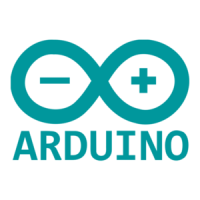Scheduled WiFi SSL Web Client (//www.arduino.cc/en/Tutorial/ScheduledWiFiSSLWebClient)
Analog to Midi (//www.arduino.cc/en/Tutorial/AnalogToMidi)
WiFi RTC (//www.arduino.cc/en/Tutorial/WiFiRTC)
Battery Life tutorial (//www.arduino.cc/en/Tutorial/MKR1000BatteryLife)
Adding mores Serial interfaces to SAMD microcontrollers (//www.arduino.cc/en/Tutorial/SamdSercom)
Please Read...
The microcontroller on the MKR1000 runs at 3.3V, which means that you must never apply more than 3.3V to
its Digital and Analog pins. Care must be taken when connecting sensors and actuators to assure that this
limit of 3.3V is never exceeded. Connecting higher voltage signals, like the 5V commonly used with the
other Arduino boards, will damage the MKR1000.
Features
Serial ports on the MKR1000
The USB connector of the board is directly connected to the USB host pins of the SAMD21. This routing
enables you to use the MKR1000 as a client USB peripheral (acting as a mouse or a keyboard connected to
the computer) or as a USB host device so that devices like a mouse, keyboard, or an Android phone can be
connected to the MKR1000. This port can also be used as a virtual serial port using the "Serial" object in the
Arduino programming language.
ADC and PWM resolutions
The MKR1000 has the ability to change its analog read and write resolutions (defaults to 10-bits and 8-bits,
respectively). It can support up to 12-bit ADC/PWM and 10-bit DAC resolutions. See the analog write
resolution (//www.arduino.cc/en/Reference/AnalogWriteResolution) and analog read resolution
(//www.arduino.cc/en/Reference/AnalogReadResolution) pages for more information.
WiFi on the MKR1000 This board is fully compatible with the WiFi101 library
(//www.arduino.cc/en/Reference/WiFi101) and examples originally made for the Arduino WiFi101 Shield.
Upgrading Firmware and uploading SSL certificates
When it is needed, the WiFi101 library is updated to implement new features. This usually requires an update
of the WiFi firmware with a specific tool. The board comes with a number of root certificates that allow the
secure connection with a wide variety of websites. If you need to use different certificates, you need to use
the same tool. Please refer to the Firmware Updater sketch and plug-in documentation, available from the
WiFi101 library page (//www.arduino.cc/en/Reference/WiFi101).
For more details on the Arduino or Genuino MKR1000, see the product page
(//www.arduino.cc/en/Main/ArduinoMKR1000).
Last revision 2017/01/11 by SM
The text of the Arduino getting started guide is licensed under a Creative Commons Attribution-ShareAlike
3.0 License (http://creativecommons.org/licenses/by-sa/3.0/). Code samples in the guide are released into
the public domain.

